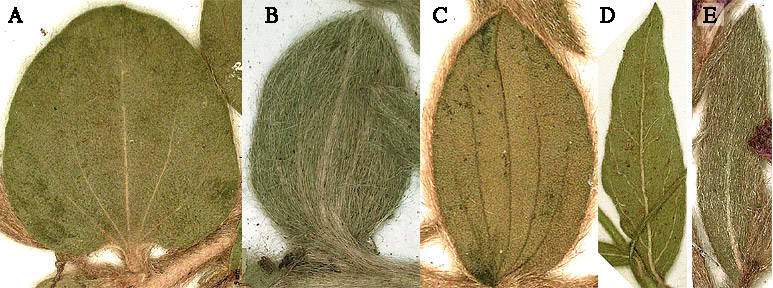
Venation types: A–C: basal acrodromous (‘palmate’); D: pinnate; E: midrib only
Venation Types for Evolvulus: Unenhanced Inspection
Leaf venation for Evolvulus is often not readily apparent, but when available provides a valuable differentia, even the primary distinctive feature for plants that are difficult to identify with the typical available keys; e.g., to distinguish E. discolor from E. nuttallianus in the Trans-Pecos and western Mexico. But venation visibility can be enhanced with leaf clearing and with light transmittance techniques to provide strong objective differentiae not otherwise always available.
In his A Monograph of the Genus Evolvulus (1934) van Ooststroom states for the genus (p. 6):
The nervation consists of a midrib and one to several pairs of lateral nerves. Often the nervation becomes indistinct owing to the dense hairiness. Generally it is most distinctly to be seen underneath. The lateral nerves arise at different heights in the leaf or they arise quite near the base. This is especially the case in leaves with a broad subcordate or cordate leaf–base. But also it occurs in narrower leaves. Here I refer to E. sericeus Sw. in which 1 or more pairs of lateral nerves always arise at the base and are long–ascending.
For selected U.S. and Mexican species van Ooststroom states:
- E. arizonicus*
- midrib generally prominent beneath, other nervation invisible or the basal lateral nerves slightly prominent beneath.
*In my own examination of many herbarium specimens of E. alsinoides and E. arizonicus I found no significant difference in venation, which is pinnate (secondary veins often obscured by pubescence).
- E. nummularius
- midrib and 2-5 pairs of lateral nerves more or less distinct beneath
- E. nuttallianus
- midrib more or less visible beneath, pale.
- E. purpusii
- midrib impressed above, other nervation invisible.
- E. prostratus
- midrib and 2-3 pairs of lateral nerves, rising from near the base, impressed above, more or less prominent beneath
- E. rotundifolius
- midrib and 2-3 pairs of lateral nerves, rising from the base, impressed above
- E. sericeus
- midrib impressed above, more or less prominent beneath; lateral nerves in the narrow leaves absent [for evidence that van Ooststroom is not correct concerning narrow leaves], in the broader ones 1 or 2 pairs from the leaf-base, long–ascending.
- E. sericeus var. discolor
- midrib and 2-3 pairs of lateral nerves, rising from near the base, impressed above, slightly visible beneath;
- E. sericeus var. discolor
Leaf venation in Evolvulus presents useful taxonomic characters, but its study and use is complicated by two factors in several Evolvulus taxa under study here:
- Leaves are characterized by low (1r) “leaf rank”, as defined by the leaf architecture working group (1999). This means the level of organization of the leaf venation is relatively low, with vein course and other characteristics not clearly visible; i.e., E. sericeus, E. nuttallianus, E. alsinoides. However, when secondary veins are visible these taxa are readily distinguished.
- Leaf venation is often obscured by pubescence; i.e., E. discolor, E. nuttallianus, E. alsinoides.
The following breakdown of venation types based on secondary vein strength and pattern in the proximal half of the leaf may be given:
- a pinnate vein course generally visible on some leaves without clearing:
- E. alsinoides, E. arizonicus, E. nummularius
- a pinnate vein course visible only with clearing:
- E. nuttallianus, E. arenarius
- a weakly paired supra-basal acrodomous vein course generally visible on some leaves without clearing;
secondary pinnate veins generally absent in the lower half of the leaf:
- E. sericeus, E. choapanus McDonald , E. purpusii
(secondaries may not be visible on mounted specimens or with normal lighting)
- secondary ascending veins often occur above the base:
- E. rotundifolius
- 1—2 (— 3) strong secondary basal acrodromous vein pairs from the very base:
- E. discolor, E. prostratus
Click here for gallery of images for testing identification of most of the above species. Obviously for species with the same type, other features are required to give a complete determination.
To check an ID in the gallery, just move the cursor onto the large image and the determination made by Bob Harms will appear on the image (in a small box), including the most recent different determination made by others (should these not agree). A general location for the specimen will also be given.

